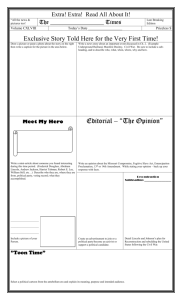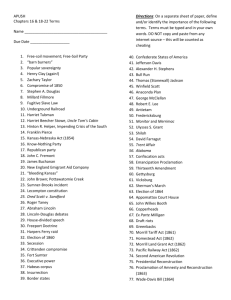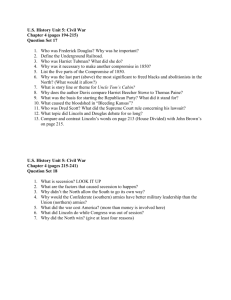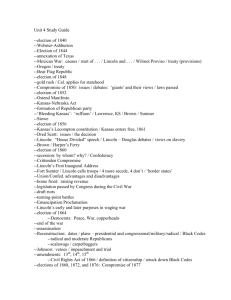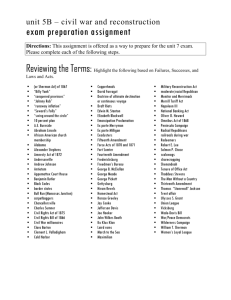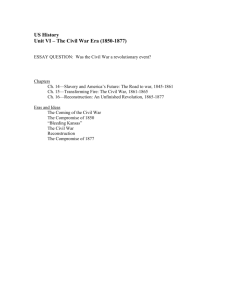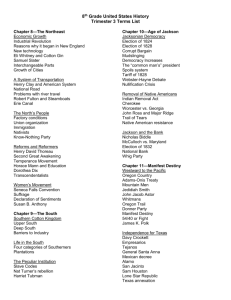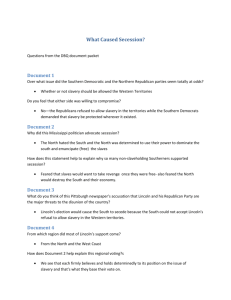file - Athens Academy
advertisement
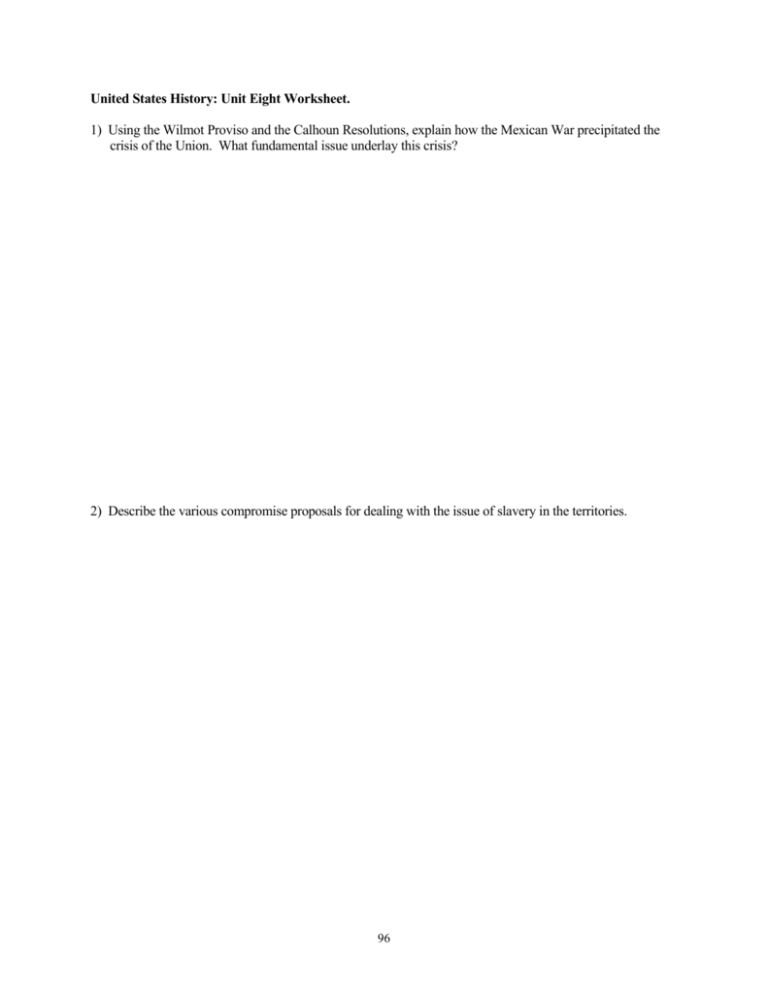
United States History: Unit Eight Worksheet. 1) Using the Wilmot Proviso and the Calhoun Resolutions, explain how the Mexican War precipitated the crisis of the Union. What fundamental issue underlay this crisis? 2) Describe the various compromise proposals for dealing with the issue of slavery in the territories. 96 3) How did the territorial issue influence the presidential election of 1848? What political parties were involved? Who were the candidates? Who won? 4) How did President Zachary Taylor propose to settle the issue of slavery in the territories? 5) Describe the major components in Henry Clay's Omnibus Bill. Who were the sectional winners and losers on each point? 97 6) Decribe the debates in Congress by the "great triumvirate" during the crisis of 1850. What did each man say? 7) How was the crisis of 1850 resolved? (Be sure to give the specifics of Stephen A. Douglas' strategy.) 98 8) Did the South make a good deal in the so called Compromise of 1850? Why? 9) Did the Compromise of 1850 remove the slavery issue from the public focus? Why? 99 10) Identify the following: a) Wilmot Proviso: b) Calhoun Resolutions: c) Missouri Compromise/ 36-30' Line: d) Popular/Squatter Sovereignty: e) Lewis Cass: f) Zachary Taylor: g) Martin Van Buren: h) Mexican Cession: i) free-soil: j) Free-Soil Coalition: 100 k) Sutter's Mill: l) Forty-Niners: m) Millard Fillmore: n) Stephen A. Douglas: o) Fugitive Slave Law: p) Uncle Tom's Cabin: q) Ostend Manifesto: r) John A. Quitman: s) William Walker: t) filibustering expeditions: 101 11) Describe the origins of the Kansas-Nebraska Act. What state did Douglas represent in the Senate? 12) How did the Kansas-Nebraska legislation affect the feelings of the North regarding the South? 13) Describe the origins of the Republican party. 102 14) Could the term "Bleeding Kansas" be appropiately applied to the Kansas Territory? Why? (Be specific.) How did the violence in Kansas spread to the Capitol in Washington? 15) Describe the candidates and platforms in the election of 1856. What did this contest say about the condition of political parties in the United States in the late 1850s? 103 16) Why was the slogan "Free Soil, Free Labor, Free Men" so important to the success of the Republican Party? 17) Describe the origins of the Dred Scott case. 18) Explain the chief components in Supreme Court's ruling in the Dred Scott case. How did the North – particularly Republicans – react? How did the South react? Did the South have a legitimate complaint against the North's reaction, especially in light of Daniel Webster's assertion during the Hayne-Webster Debate of the 1830s that the Supreme Court was the proper constitutional agent for resolving disputes between the sections? 104 19) Describe the struggle both in Kansas and in Washington over the Lecompton Constitution. 20) What caused the Panic of 1857? Which section weathered this financial crisis best? What were the consequences? 21) Describe the key points made by the two candidates during the Lincoln-Douglas Debates in 1858. Why were Lincoln and Douglas debating? What was the importance of these debates? 105 22) How did events such as the northern reactions to Ableman v. Booth and John Brown's raid at Harpers Ferry impact southern views of the North? 23) Identify the following: a) Gadsden Purchase: b) "Appeal of the Independent Democrats": c) Anthony Burns: d) Eli Thayer: e) Border Ruffians: f) "Sack of Lawrence": 106 g) Pottawatomie Creek Massacre: h) "Crime Against Kansas": i) Preston Brooks: j) John C. Fremont: k) "Free Soil, Free Labor, Free Men": l) Dred Scott v. Sandford: m) Roger B. Taney: n) obiter dictum: o) "Alabama Platform" of 1848: p) "Georgia Platform" of 1850: q) Freeport Doctrine: 107 r) Ableman v. Booth: s) John Brown: 24) Explain what happened to the Democratic party during the presidential contest of 1860. How did the fate of the Democratic party influence the outcome of the election? How did the outcome of the election lead to secession? How did secession lead to the Civil War? 108 25) Describe the Republican platform of 1860. 26) Explain the statement: "Attitude followed lattitude." 27) Describe the outcome of the election of 1860. 109 28) What about Lincoln's election made southerners believe secession an immediate necessity? 29) How did President James Buchanan respond to the secession crisis? 110 30) Describe the various compromise proposals promulgated between Lincoln's election and inauguration. Why did they all fail? 31) Describe the main points in Lincoln's inaugural address. 111 32) Describe the events leading up to the conflict at Fort Sumter. 33) How did Lincoln respond to the firing on Fort Sumter? What impact did this have on the actions of the Upper South? 112 34) Describe Lincoln's actions in his effort to hold on to the border states? Was he justified by circumstances in taking these actions? What about constitutional restrictions on such actions? 35) Identify the following: a) Herschel V. Johnson: b) John C. Breckinridge: 113 c) Abraham Lincoln: d) John Bell: e) Stephen A. Douglas: f) Jefferson Davis: g) Montgomery, Alabama: h) Alexander H. Stephens: i) Thomas Reade Rootes Cobb: j) Howell Cobb: k) William H. Seward: l) Salmon P. Chase: 114 m) Edwin M. Stanton: 36) What advantages did the North possess in its struggle with the South? 37) What advantages did the South possess in its struggle with the North? 115 38) Identify the following: a) General Winfield Scott: b) "Anaconda Strategy": c) Conscription Acts: d) General Irwin McDowell: e) Bull Run/First Manasass: f) General George B. McClellan: g) Peninsula Campaign: h) Seven Days Battles: i) General Joseph E. Johnston: j) General Robert E. Lee: 116 k) General John Pope: l) Army of the Potomac: m) Army of Northern Virginia: n) Second Bull Run/Second Manasass: o) Antietam: p) Fredricksburg: q) General Ulysses S. Grant: r) Forts Henry and Donnelson: s) General Henry Halleck: t) New Orleans: 117 u) "war powers": 39) Trace the evolution of emancipation from the beginning of the war to the adoption of the Thirteenth Amendment. What role did the battle of Antietam play in this process? war fatigue? Could it be said that the Civil War began as a war against secession and ended as a war against slavery? Was the North morally more justified in its war aims at the beginning of the war or at the end? 118 40) Identify the following: a) General John C. Fremont: b) General David S. Hunter: c) General Benjamin "Beast" Butler: d) "contraband": e) Preliminary Emancipation Proclamation: f) Emancipation Proclamation: g) Thirteenth Amendment: h) Morrill Tariff of 1861: i) Transcontinental Railroad Acts: j) Homestead Act of 1862: 119 k) Morrill Land Grant Act of 1862: l) National Banking Act of 1863: m) Contract Labor Act of 1864: n) graduated income tax: o) Bureau of Internal Revenue: p) "greenbacks": q) Legal Tender Act of 1862: r) Jay Cooke: s) Radical Republicans: t) Joint Committee on the Conduct of the War: 120 u) Peace Wing of the Democratic Party: v) "Copperheads": 41) Describe the impact of the Civil War on civil liberties in the North. 42) Describe the role played by the northern Democrats during the Civil War. 43) Describe the election of 1864 in the North. 121 44) Compare and contrast the governmental policies of the Lincoln and Davis administrations. 45) Identify the following: a) Clement L. Vallandigham: b) "tax in kind": c) Trent Affair: d) Laird Rams: 122 e) General Joseph Hooker: f) Chancellorsville: g) General Thomas J. "Stonewall" Jackson: h) Gettysburg: i) Wilderness: j) Spotsylvania Courthouse: k) Cold Harbor: l) The Crater: m) Petersburg: n) Appomattox: 123 o) Vicksburg: p) Chickamauga: q) Kennesaw Mountain: r) General Joseph E. Johnston: s) General John B. Hood: t) Atlanta: u) Sherman's March to the Sea: v) General George H. Thomas: w) Franklin: x) Nashville: y) Bentonville: 124 United States History: Unit Nine Worksheet. 1) Who favored an "easy peace" policy? a "hard peace" policy? Why? (Pay particular attention to the motives of the "hard peace advocates.) 2) Describe the details of and the motives behind Lincoln's "Ten Percent Plan of Reconstruction." 125 3) Describe the details of and motives behind the Wade-Davis Bill. 4) Describe the details of and motives behind Johnson's plan of restoration. 126 5) How did the actions of the South serve to make the task of "easy peace" advocates nearly impossible? 6) Describe the evolution of the Radical Republican plan of reconstruction. 127 7) Who were the Radicals? 8) Why is 1866 referred to as "the critical year"? 128 9) Outline the main points in the Fourteenth Amendment. 10) Describe the details of and motives behind the Military Reconstruction Act. 129 11) Identify the following: a) pocket veto: b) "pernicious abstraction": c) John Wilkes Booth: d) Mary Suratt: e) Samuel Mudd: f) "forty acres and a mule": g) Black Codes: h) Carl Schurz: i) Joint Committee on Reconstruction: j) Benjamin Wade, George Julian, Thaddeus Stephens, Charles Sumner: 130 k) "conquered provinces" l) "state suicide": m) "forfeited rights": n) Freedmen's Bureau: o) Civil Rights Act: p) National Union Convention: q) "swing around the circle": r) Command of the Army Act: s) Tenure of Office Act: t) Edwin M. Stanton: u) Military Reconstruction Act: 131 v) Blaine Amendment: w) Albion Tourgee: x) Fifteenth Amendment: 12) Describe the role of the Supreme Court in the Reconstruction process. (Be sure to discuss all the major cases.) 132 13) Describe the events surrounding the impeachment of Andrew Johnson. 14) How "radical" was Radical Reconstruction? Did this truly represent a period of "Negro rule" in the South? Why did Radical Reconstruction fail? 133 15) Explain the term "White Terror." How did southerners use this strategy to frustrate the reconstruction process? 16) Explain the events surrounding the "Compromise of 1877." 134 17) Identify the following: a) Union League: b) Hiram R. Revels: c) Blanche K. Bruce: d) "Black Reconstruction": e) "carpetbaggers": f) "scalawags": g) Ku Klux Klan: h) Enforcement Acts: i) "color line": j) Mississippi Plan: 135 k) "Red Shirts": l) "bloody shirt": m) Wormley House Conference: 136 United States History: Unit Ten Worksheet. 1) What did Henry W. Grady and others mean when they spoke of the "New South." 2) Describe the role of industry in the postbellum South. 3) Describe the role played by agriculture in the postbellum South. 137 4) Describe the role played by tennancy and the crop-lien system in postbellum southern agriculture. Why did this system prove so devastating to southern agriculture? 5) Who were the "Bourbon Redeemers"? Explain the origin of that name. 6) Describe the role played by "Bourbon Redeemers" in the politics of the postbellum South. 138 7) Explain the role played by African-Americans in the politics of early years of "Bourbon Redeemer" dominance. How did the rise of the Populist party impact the role of African-Americans in postbellum southern politics? What was the "Second Mississippi Plan"? How did it differ from the "First Mississippi Plan"? (See Unit Eight.) How did other southern states build on the "Second Mississippi Plan" to effectively end African-American participation in southern politics? 8) Describe the "Jim Crow" system. How did rulings by the Supreme Court assist the South in implementing this system of strict racial segregation? How did "Jim Crow" impact African-Americans? 139 9) Compare and contrast the policies of Booker T. Washington and W. E. B. DuBois. Which of these two leaders do you believe had the better philosophy? Why? 10) Identify the following: a) "the lost cause": b) International Cotton Exposition of 1881: c) John Ruffin Green: d) Duke Family: e) American Tobacco Company: 140 f) "Pittsburgh of the South": g) Seaman Knapp: h) Peabody Fund for Education: i) John F. Slater Fund: j) convict leasing system: k) Readjustor Party: l) color line: m) poll taxes, head taxes, literacy tests: n) understanding clause: o) grandfather clause: p) John Marshal Harlan: 141 q) segregation: r) Civil Rights Cases: s) Plessy v. Ferguson: t) "seperate but equal": u) "Atlanta Compromise": v) Conferences on Negro Problems: 11) Define frontier. Describe where the frontier was located at different stages of American development. 12) What motivated people to risk life on the frontier? 142 13) What are the sections which combine to make up the Trans-Mississippi West? 14) Describe the role played by railroads in opening up the west. 15) Describe the fate of the Native Americans of the Trans-Mississippi West during the nineteenth century. 143 16) Describe the impact of Helen Hunt Jackson's book, A Century of Dishonor on American Indian policy between 1881 and 1924. 17) Describe the role of mining in the Trans-Mississippi West. 18) Describe the rise and fall of the "cattle kingdom" in the Trans-Mississippi West. 19) Describe the role of agriculture in the Trans-Mississippi West. 144 20) What were the factors which encouraged settlement of the Great Plains? Describe the role played by the federal government in encouraging this settlement. Describe the role played by technology in making this settlement possible. 21) How did the environment influence the settlement of the Great Plains? 22) Who was Fredrick Jackson Turner and what was his "frontier thesis"? How has this thesis impacted subsequent historical study of the role of the frontier in United States history? 145 23) Identify the following: a) "Great American Desert": b) Plains Indians: c) Battle of the Little Bighorn: d) Colonel J. M. Chivington: e) reservations: f) Indian Peace Commission: g) Report on the Condition of the Indian Tribes: h) General Philip Sheridan: i) Black Hills: j) Sitting Bull: 146 k) Crazy Horse: l) Chief Joseph: m) Geronimo: n) Ghost Dance: o) Wounded Knee: p) Dawes Severalty Act: q) Burke Act: r) Wheeler-Howard Act: s) Forty-Niners: t) Pike's Peak: 147 u) Comstock Lode: v) "the long drive": w) open range: x) wheat belt: y) "Kansas brick": z) Homestead Act of 1862: aa) bonanza farms: bb) "safety valve": cc) Newlands Reclamation Act of 1901: 148 United States History: Unit Eleven Worksheet. 1) Describe the role played by the expansion of the nation's railroad system in the rise of industry within the United States. 2) What role did technological developments play in the rise of American industry? Give special attention to the importance of the application of electricity to communications and power. 149 3) Identify the following: a) Pacific Railway Acts of 1862 and 1864: b) "robber barons"/"captains of industry": c) Alexander Graham Bell: d) Thomas Alva Edison: e) George Westinghouse: 4) Why were old methods of business organization inadequate for the the needs of big business? What new form of business organization overcame these inadequacies? How? 150 5) Identify the following: a) limited liability: b) monopoly: c) pool: d) trust: e) holding company: f) interlocking directorate: g) merger: h) Cornelius Vanderbilt: i) John D. Rockefeller: j) Andrew Carnegie: 151 k) horizontal integration: l) vertical integration: m) John Pierpont Morgan: 6) Explain Andrew Carnegie's philosophy of stewardship as outlined in "The Gospel of Wealth." To what extent did most Americans endorse this philosophy of self-improvement? 7) Describe the distribution of wealth in the United States between the end of the Civil War and the early twentieth century. 152 8) How did the rise of industry impact the relations between owners and workers? 9) How did workers respond to this changing relationship? What factors hindered the efforts of workers to organize? 10) Trace the rise and fall of the Knights of Labor. 153 11) Trace the evolution of the AFL-CIO. 12) Identify the following: a) Commonwealth v Hunt: b) Molly Maguires: c) Railroad Strike of 1877: 154 d) Uriah S. Stephens: e) Terence V. Powderly: f) Haymarket Affair: g) Samuel Gompers: j) "bread and butter unionism": k) Pullman Strike: l) Eugene V. Debbs m) Attorney General Richard Olney: n) injunction: o) Danbury Hatter's Strike: 155 p) Daniel DeLeon: q) Victor Berger: r) Woody Guthrie: s) Pete Seeger: t) "The Little Red Songbook": 13) Discuss the role of Marxism in the American labor movement. 156 14) Discuss the rise and fall of the IWW. 15) Explain the rapid growth of urbanization in the decades following the Civil War. 157 16) Analyze the reasons for the wave of nativism that swept the United States in the closing decades of the nineteenth and early decades of the twentieth centuries. How did nativists seek to limit or eliminate the influx of immigrants (be specific)? 17) Discuss the plight of Chinese immigrants during these years. 158 18) Identify the following: a) "new immigration": b) American Protect Association: c) Henry Cabot Lodge: d) Emergency Immigration Act of 1921: e) Immigration Act of 1924: f) "Gentleman's Agreement": 19) Explain the factors behind the appearance of new cities between 1860 and 1910. 20) Describe the factors that made the vertical and horizontal growth of cities possible. 159 21) Describe the importance of private enterprise to urban growth. Did city governments play a role of any importance in this process? If so, what? If not, why not? 23) What problems did the growth of cities create? How did city government attempt to cope with them? What were "political machines"? 24) Describe the significance of the city planning movement. 160 25) Identify the following: a) Elisha Graves Otis: b) steel frame construction: c) William LeBaron Jenny: d) Louis Sullivan: e) Carson, Pirie, Scott, and Company: f) Woolworth Building: g) Frank Sprague: h) "streetcar suburbs": i) subways: j) James B. Eads: 161 k) Washington Roebling: l) "private city": m) "dumbbell" tenements: n) Tenement House Law of 1901: o) Tammany Hall: p) George Washington Plunkitt: q) Frederick Law Olmstead: r) "White City": 162 26) Describe the impact of Charles Darwin's On the Origin of Species on social thought after its publication in 1859. Explain the role of Herbert Spencer in furthering Darwin's impact. 27) How did Edward Livingston Youmans and William Graham Sumner popularize "social Darwinism" in the United States? 28) Discuss Lester Frank Ward's challenge to "social Darwinism." 163 29) Identify the following: a) Henry George: b) Henry Demarest Lloyd: c) Thorstein Veblen: d) Edward Bellamy: 30) Describe the response of Protestant and Catholic churches to the problems of urbanization as embodied in the "social gospel." 31) Discuss the settlement house movement. 164 32) Describe the movement for women's rights between 1865 and 1917. 33) Identify the following: a) Young Men's Christian Association: b) Salvation Hospital: c) "institutional church movement": d) Washington Gladden: e) Walter Rauschenbusch: f) Pope Leo XIII: g) Samuel Coit: 165 h) Jane Addams/Ellen Starr/Jean Fine/Lillian Wald: i) Susan B. Anthony: j) Elizabeth Cady Stanton: k) National Woman Suffrage Association: l) American Woman Suffrage Association: m) National American Woman Suffrage Association: n) Anna Howard Shaw: o) Carrie Chapman Catt: 166 United States History: Unit Twelve Worksheet 1) Compare the old and new political history. 2) Identify the following: a) Lord James Bryce: b) “party of morality”: c) “party of personal liberty”: d) American Protective Association: e) prohibition and local option: 167 3) Discuss the scandals of the Grant administration and their impact on American politics. 4) Identify the following: a) “Ohio Idea”: b) greenbacks: c) “easy money policy”: d) “sound money policy” e) Liberal Republicans: 168 f) Credit Mobilier Company: g) Panic of 1873: h) “His Fraudulency” and “Old Eight and Seven”: i) Stalwarts: j) Half-Breeds: k) Roscoe Conkling: l) British Civil Service Act of 1870: m) Carl Schurz and John Sherman: n) Charles Guiteau: 169 o) Pendleton Civil Service Act: 5) Identify the following: a) Mugwumps: b) “Mulligan Letters”: c) Belshazar Blaine’s Feast with the Money Kings”: d) “Rum, Romanism, and Rebellion”: e) Texas Seed Bill: f) Grand Army of the Republic: g) Corporal James Tanner: 170 h) Dependent Pension Bill: i) Interstate Commerce Commission: j) “Murchison Letter”: k) “Billion Dollar Congress”: l) Sherman Anti-Trust Act: m) Sherman Silver Purchase Act: 6) Discuss the significance and development of civil service reform. 171 7) Identify the following: a) wets: b) drys: 8) Explain the origins of the agrarian revolt. 9) Explain the role of the currency issue in Gilded Age politics. 172 10) List and explain the six demands of the Populist party as enunciated in the Omaha Platform of 1892. 11) Identify the following: a) Munn v Illinois: b) Wasbash Railroad v Illinois: c) mail-order houses: d) Grange: e) Greenback-Labor Party: 173 f) “Crime of `73: g) Farmers’ Alliances: h) Dr. Charles W. Macune: i) sub-treasury system: j) graduated income tax: k) natural monopoly: l) unnatural monopoly: m) Ignatius Donnelly: n) “status anxiety”: 174 o) Jacob Coxey and the “Army of the Commonweal of Christ”: p) Sixteenth Amendment: q) American Bimetallic League: r) Coin’s Financial School: s) “Cross of Gold”: t) “front-porch campaign”: v) “full dinner pail”: w) “the Grand Conjuncture” 175 12) Identify and explain the five main themes of Populism. 13) Explain the disappearance of the Populist party. 176
